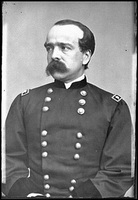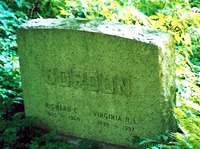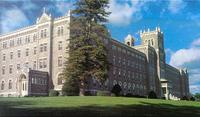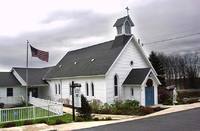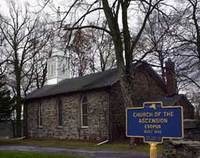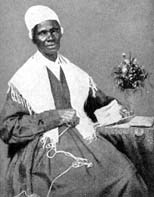Neighbors of the Estate
Beatty Beavers Burroughs Butterfield Gordons Pells St. Cabrini Home (Irish) Christian Brothers Mount St Alphonsus
Sacred Heart Church Church of the Ascension Ascension Cemetery Holy Cross Monastery Black Creek Forest Preserve Sojourner Truth
Beatty Robert Beatty owned property just north of the Payne property.
Beavers were an English family who came to Esopus in the early 1700s. The Beaver name appears in many locations in Esopus. The family cemetery is located on Black Creek Road, where it formed the westernmost edge of the Payne property. About 60 Beavers are buried there. Just up the hill from the cemetery was a stone house belonging to the Beavers, in use until about 1909, but it has since been demolished. The 'Beaver homestead' is a house directly opposite the entrance to Mt St Alphonsus along Peter's Lane, just south of Esopus Avenue.
The Beavers seem to have settled on lot #12 of the New Paltz Patent. Robert Livingston Pell purchased some land from them and the descriptions show his parcel surrounded by other Beavers, or by Relyea, whose wife was a Beaver , both of whom are buried in the Beaver cemetery. Other deeds describe the northern slice of Payne property as being occupied by John Beaver and then by his son, John Oliver Beaver. Myer Beaver donated the first land for Ascension Cemetery.
John Burroughs was born April 3, 1837 on the family farm in Roxbury, New York and died on a train while returning from California on March 29, 1921. He was buried on the Roxbury farm on his eighty-fourth birthday, April 3, 1921, at the foot of Boyhood rock on which he had played as a child. In his time he was an immensely popular nature writer, and is probably the most famous person associated with West Park/Esopus/Ulster. His popularity resided in the fact that readers appreciated the way of life he wrote about and came to exemplify --- the tantalizingly elusive yet universally accessible --- simple values, simple means, simple ends.
By the time he was 20 years old Burroughs had moved from one pole to the other as far as his feelings about writing were concerned. From an early schoolboy aversion to any thought of writing, he had become determined to be an author. In an 1857 letter to his bride of one week he wrote, "I sometimes think I will not make the kind of husband that will always suit you. If I live, I shall be an author. My life will be one of study. It may be a weakness in me to cherish the thoughts I do, but I can't help it."
In 1867, Burroughs issued his first book, Notes on Walt Whitman as Poet and Person. It was the first Whitman biography to be published. When it appeared, Burroughs had been working as a government employee in Washington, D.C. for four years, practicing his craft at every opportunity, polishing his skills, finding his niche. Burroughs was being published in at least three periodicals: The Bloomville Mirror, Saturday Press, and the New York Leader. Much of what he wrote appeared under the pseudonyms "Philomel" and "All Souls"
In 1871, four years after the appearance of Notes . . ., Wake-Robin was published by Hurd and Houghton (now named Houghton Mifflin) It was the first book in which the familiar Burroughs, the writer of essays about Nature, was distinctly present. It was the first in what eventually became a set of 23 volumes of collected essays, the last three of which were published posthumously. Subject matter of the 23 volumes is not limited to Nature, though it is the dominant theme. Philosophy, literary criticism, and travel are also to be found in good supply. (click here for a longer biography of John Burroughs.)
Julian Burroughs (b 1878 -- d 15 December 1954) was adopted by John and Ursula Burroughs in 1878. He was a natural son of John -- a fact which Ursula did not discover until years later. Frequently Julian accompanied John on his walks and travels. He was sent to prepare for college to the Riverview Military Academy in Poughkeepsie, and then went on to Harvard, from which he graduated in 1901. He and his wife Emily had three children, Elizabeth (b 12 August 1903 - d 15 Nov 1999), Ursula (b 19 June 1905 - d unknown) and John (b 21 July 1909 - d Nov 1968). In 1913, Julian was hired to be the superintendent of the Payne estate ( click here for Julian Burroughs' description of his time as superintendent), and remained in that position until early 1918, when he moved back to Riverby, which John Burroughs had deeded to Ursula in 1892 and was willed to Julian when Ursula died in 1917. Julian was very artistic, and designed several of the buildings on the Payne estate: the boathouse, the icehouse, and the large barns (which were handed over to a different architect by the Binghams in 1918). In 1915, he designed and built the stone bridge over the creek on what is now Black Creek Road, but then was the main road from Kingston to Newburgh. He devoted himself to raising specialty grapes.
His daughter Ursula married William Love (b 28 May 1898; died West Park Aug 1973) and lived in the Riverby house. Later, in the 1930 census, Ursula is listed as living in Marbletown, and her husband is listed as a teacher at Mohonk House. William Love was born in Tennessee, and his parents were from Tennessee and Mississippi. Julian Burroughs and his family are listed as living on Pearl Street in the City of Kingston in the 1920 census, This is probably to enable the children to attend the regional high school without the difficult trip up and down from West Park. He is described as a fruit grower on his own land, hardly a description of Pearl Street between Wall and Greene, which is almost dead center in the historic district.
Elizabeth Burroughs Kelley is important to our story because she lived on the Payne estate from 1913 to 1918. I know little about her, but note that her social security card was issued from New Jersey. She became the most authoritative historian of Esopus; her essay in the Esopus book is the best introduction to the detailed history of West Park. In the 1990s she often visited the Marist property, regaling the Brothers with stories about Oliver Payne and the entire history of West Park. She also worked to keep the memory of her father, editing his personal journal. (click here for Elizabeth Burroughs-Kelley's description of her life as a teenager on the Payne estate.)
Major General Daniel Adams Butterfield. General Daniel Butterfield. (b 31 December 1831 -- d 17 July 1901) was the son of John Butterfield, who with Wells and Fargo formed the American Express Company. Daniel's wife purchased 163 acres just south of the Payne property in 1866, and they used the place for summer residence until she died in 1879. Butterfield remarried in 1886, and in 1893 relocated to Cold Spring. He had sold the bulk of his farm to John Mulford in 1882, and in 1893 he donated the last 13 acres of his property to Ascension Church, where he was a vestryman and represented the Church as a lay delegate at the Diocesan Convention from 1873 to 1893. Butterfield rejoined American Express after he left the Army in 1870. (Click here for more on the Butterfields and American Express.)
Lot Number 9 of the New Paltz Patent: Gordon Dr Richard Gordon and wife purchased the property immediately south of the Payne property in 1926, according to Elizabeth Burroughs-Kelley. This tract is lot number ten of the original New Paltz River Patents, owned in the late 18th century by Abraham Donaldson and willed to his son John Donaldson in 1806. Rev. Jennifer Barrows, pastor of the Church of the Ascension, indicates that the property remains in the family, and offered to introduce me to the present owners. (November 11, 2001). I was also referred to Ann Gordon by Lornie Hiller, the caretaker of Ascension Cemetery (December 27, 2001), but this may not be a member of the family, as there are many Gordons in Ulster County. Barbara Osberg Matthews believes the Gordons lived in New York City and use the property mainly as a summer residence, but the house nearest the road was lived in year-round by a caretaker.
The Pells of Esopus were part of the Pell family from Pelham Manor in Westchester County and Pelham and Throggs Neck in the Bronx., and were related to the Livingstons, and the Duanes. The first mention we have relating to the Payne property is in the deed of October 22,1827 between Alfred Sands Pell and his wife Adelia (daughter of Colonel James Duane and Mary Livingston) of the city of New York and John Johnston Cameron. There is a matching indenture Cameron-to-Pell of the same date. Apparently there must have been squatters or settlers on the land in question, which stretched about a third of a mile south from the mouth of Black Creek, and Pell was obliged to assert ownership of the land. This usually meant a bailiff or lawyer seized the land, even though the settlers may have had right to remain on the land for a period of time. Some of the Hardenbergh Patent land leases were for 'three lifetimes', after which the title reverted back to the original owner. At other times a person who had developed the land retained certain rights; and widows by law were entitled to a dower or portion of the property owned by their husbands.
Alfred Sands Pell (b 1 May 1786; d 20 April 1831) purchased an estate in Esopus of 114 acres on the Hudson just above Esopus Island, and at the same time a tract of 143 acres, also on the river, at the northern end of what is now West Park. At his death he left the former and the Esopus Island to his oldest son, Robert Livingston Pell, and the latter to his widow and younger children (James Duane Pell, John Augusta Pell, George W. Pell and Richard M. Pell). James and Richard's names appear on several deeds in the Ulster County records, but it is doubtful if they changed their primary residence to Ulster, or even used it as a summer residence. More likely they were simply real estate investors As part of their expansion, James Duane Pell purchased the lower half of the Payne tract from the Widow Wurts in 1837 for $8,000 of which $7,000 was a mortgage to the Widow payable in a balloon payment in 1842, but then sold it in 1840 to Archibald Russell. Alfred Sands Pell's nephew, also named Alfred Sands Pell (1805 - 1869), an agent for a an English marine insurer, was a cofounder of Mutual Life Insurance Company of New York (MONY) in 1843, which by 1870 became the leading insurer in the country. It had introduced advertising and door-to-door sales.
Robert Livingston Pell (b 10 May 1811, d 13 Feb 1880) had graduated from Harvard and made the Grand Tour of Europe. After he married Maria Louisa Brinkerhoff in 1837, he moved from New York City to the Esopus property where he built a brick house in the then popular Tuscan Revival style of a Roman villa, described by one visitor as "Greek without and Roman within". It was 70 feet square. The dining room, 28 feet long, was hung with pictures which were copies of masterpieces of Italian painting. Around this mansion lay the productive and landscaped acres of Pelham Farm, which was among the wonders of its day because of its orchards, its vineyards, its three fishponds, its wharves from which Pelham Farm apples were shipped to Europe and even to China. He is said to have had 25,000 apple trees. His specialty was the Yellow Newtown Pippin apple, a long-keeping apple largely exported and known in England by the time of the American Revolution. In the mid 1840s,Pell built a dock on the river with a large stone warehouse, where his apples were sweated to prepare them for their European journeys. It is said that they lasted nine months with this treatment.
The Hudson By Daylight Map of 1878 shows the estate of Robert Pell on the west side of the Hudson south of Esopus Village. The map states that Pell's farm was 1200 acres. His residence was located north of Esopus Village.
Robert Pell was exceptionally community minded. He gave land for the Ascension Cemetery, and contributed to the construction of Esopus United Methodist Church and donated land for Sacred Heart RC Church in the village of Esopus, as well as fencing and landscaping.
In the mid 1850s, Robert Pell announced that he would build a competitor to the Catskill Mountain House on Overlook Mountain near Woodstock. Several others had attempted to do this beforehand, usually they were based around Kingston, and were jealous of the prosperity that Catskill Mountain House brought to the town of Catskill. The views from Catskill Mountain House were spectacular, and the establishment got a free commercial from James Fenimore Cooper when he interpolated some speeches by Natty Bumppo, the Leatherstocking, in Cooper's two volume novel The Pioneers. (Around 1966, Ed Cashin led some of us to the now abandoned site of the Mountain House and read Natty Bumppo's description of the Hudson Valley. It looked just about the same, with very little evidence of civilization from our elevated position above the Hudson Valley clear to the east ridge of the Berkshires!) But the views from Overlook were even more spectacular. The promoters reckoned that they might be able to build a railroad to the Overlook, and make it simpler for tourists to visit. Unfortunately, the recession of 1857 hit Robert Pell hard; and the Civil War ruined his apple export business. He was forced to sell his holdings. In 1869, he sold his holdings to his son-in-law, John B. Ireland, who 35 years later sold a major portion to the Redemptorist Fathers.
One sad remnant of this story impacts us directly. In 1871, Jacob Robertson foreclosed on a mortgage of Robert Pell for the northwestern section of the Payne tract, across from the old 9-W, and held it until 1886, when the executors of his estate sold it to widow Anna Pratt, who would then hold title to the entire northern slab of what was to become the Payne tract. The description of the tract is interesting in that it is described by its neighbors, not by distances or directions, and is described as the homestead farm of John Beaver, bounded on the north by lands of Nicholas Murphy and the factory lot, on the east by lands of Pell and Mrs. Pratt, on the South by lands of Mrs. Pratt and Archibald Russell, and on the west by the factory lot and lands of Cornelius Relyea, who was married to a Beaver and is buried in the Beaver cemetery.
Neighbors north of the Marist Property
Lands in lots number 11 and 12 of the New Paltz Patent was once owned by the Pells. (See liber 31 page 463) who sold the section in lot 11 to the Pratts. ( liber 108 page 566). When the economy turned sour, the land north of the Marist property up to the mouth of Black Creek was purchased by John B Ireland, the son-in-law of Robert L. Pell, who also purchased several other parcels to keep the Pell Farm intact for his wife, who was the only heir of Robert and Maria Louisa Pell. In 1906, the Irelands sold the property to Robert A Beatty, a New York City resident. The deed was found to be defective, and Beatty sued to have a reformed deed. Both Ireland and his wife had died, and the executors contested the action. Finally in 1915, a reformed deed was issued to Beatty. In 1942, after Robert Beatty died, his widow, Georgie Beatty sold the tract to Marcus William Hulme (liber 682 page 418) a resident of Elmhurst, L.I. In turn, Hulme sold the parcel in 1948 to Robert C and Pauline D Richter (liber 704 page 470). The Richters established a group of cottages on the land near the Hudson. In 19??, their son, Robert Richter, Jr, moved to Esopus with his wife, Theresa, where they raised two daughters. In 1990, the tract was transferred to Robert Richter Jr , who arranged in 1992 to convey the largest part of the tract to Scenic Hudson Inc, where it became the Black Creek Forest Reservation. Bob set aside seven acre tracts for each of his two daughters, Kathy Weitze and Margaret Richter. These tracts are immediately adjacent to the Marist property, and an emergency access road leads from Marist to the Weitze tract. Kathy and Peter Weitze built a beautiful home on their tract and live there with their children. The Richters have been friends of the Brothers for over five decades. Bro Leonard Voegtle's parents used to stay at the Richter complex during the summers when Leonard was stationed in Esopus (Bob Richter calls him "Ken", as that's how his parents referred to him. In fact, Mrs. Voegtle died on the Richter property in 1982. Bob Richter reserved a lifetime interest in the section of the property with the bungalows and his house. This section passes to Scenic Hudson and the Black Creek Forest Preserve when Bob dies. For the two seven acre tracts, if either daughter wishes to sell her property, the other daughter has the first option, and Scenic Hudson has the second option.
St Cabrini Home was purchased by Mother Cabrini (1850 - 1917) from the Jesuits, who when they owned it called it Manresa ( a location in Spain strongly associated with St. Ignatius Loyola) Institute. When the property proved too small, the Jesuits purchased property on the east shore, calling it St. Andrew's, which was used as a Novitiate until about 1968, and is now owned by the Culinary Institute of America.
There is a charming story about the purchase, probably apocryphal, but worth relating. It seems that the Jesuits abandoned the site because they could not find a sufficient source of water in artesian wells for their prospective use. Along came a little nun who could hardly speak English. Voila! However, the little nun, St. Cabrini, brought in well drillers, pointed out where they ought to drill, and found plenty of water!
The property was first used as an orphanage for New York City girls of Italian heritage, as part of the Catholic Church's efforts to service the Italian immigrant community. The censuses of 1900 and 1910 contain long lists of children who were housed at the home, sometimes called "Sacred Heart Home"; most of the children were of Italian origin. Later when that function was phased out, it became a senior citizen residence.
(Irish) Christian Brothers purchased property called Glen Albyn together with some other land nearby. This property had been purchased by Archibald and Helen Russell after they sold the Payne property to John Jacob Astor. The Brothers used this property as a novitiate, and there is a cemetery for the Brothers on the site.
Mount St Alphonsus was built between 1904-1907. The Redemptorist Seminarians came to the Mount to do their theological studies, after having spent seven years in initial formation.
Prior to the Mount's construction, the land was owned by Robert Livingston Pell. The land was reputed as the greatest fruit farm in the country, with apples and grapes being shipped to European markets. When the Redemptorists found the land, the Very Reverend William Licking, C.Ss.R. was heard to say "This is my rest forever and ever, here will I dwell for I have chosen it."
The property contains many buildings, some were left over from its original use as a farm. Students had cattle, horses, pigs, chickens, and crops that included corn, potatoes, apples, and grapes. The wine used for Mass was made on the property. There was also a separate building for laundry. The property expanded beyond its original 235 acres because neighboring sections of land have been donated to the Redemptorists over the years. Guastavino Fireproof Construction Company was the subcontractor for the vaulting system used for the ceiling of the chapel of the main building.
Due to the diminishing number of seminarians, the theologate program was transferred to the Washington Theological Union in Washington, DC.
The Mount St Alphonsus www.msaretreat.com webpage says:
Mount St. Alphonsus is perfect for so many reasons!
Our castle-like building is located on more than 400 acres, and overlooks the Hudson River. With so much land, we guarantee that if you want to take a walk and have some quiet time to yourself, you will succeed in that goal!
Take a walk along the shores of the Hudson River, enjoy a walk through nature's beauty on one of our trails, sit and relax in one of our fields, walk through our outdoor Stations of the Cross--enjoy the grounds of the Mount!
Not only are we proud of our grounds, we're also proud of our enormous building! With hallways over 440 feet long (that's more than 30% longer than a football field), when we say our building is big, we mean it's big! We have over 100 bedrooms spread out over 6 floors, and can sleep 160 people. Our conference rooms can sit between 20 and 300 people, so we're capable of hosting just about any size group! Our professional kitchen staff takes pride in serving our guests 3 great meals each day in our very large dining hall, which seats up to 250 people!
Visitors to the Mount always remark about our incredible chapel. Known as one of the world's most beautiful chapels, you could spend hours just walking around our chapel and studying the beautiful stained-glass windows, statues (some dating back to the 1500's), marble floors, relics that line the walls, and other great items, including a cassock once worn by Pope Pius X!
Before heading home, feeling spiritually refreshed, don't forget to stop by our gift and book shop, home of many religious items from postcards to jewelry.
One thing we're pretty sure about… you'll want to come back and visit us again--we hope you do
Sacred Heart Roman Catholic Church. Located on the west bank of the Hudson River in Ulster County, Sacred Heart celebrated its 125th anniversary recently. Actually it is not a parish: it is a mission of Presentation of the Blessed Virgin Mary in Port Ewen. But to the people who come to Mass and devotions at Sacred Heart, who teach the faith to its children, run its programs and take part in activities, it is a parish. The way they talk about it brings to mind the words in the Acts of the Apostles about the first Christian community: "They were of one heart and one soul."
The church was built on land donated by a prominent local businessman, Robert Livingston Pell, who also gave $500 toward the cost of construction. Some Catholics in the area, eager for a church of their own, contributed a month's salary, between $20 and $40. The church opened August 15, 1875, and was staffed at first by priests of the archdiocese.
In 1904, the Redemptorists began building a seminary, Mount St. Alphonsus, less than a mile north of the church. In 1913, at the request of Cardinal John Farley, the congregation took over the operation of Presentation of the Blessed Virgin Mary and Sacred Heart. They no longer staff Presentation but remain at Sacred Heart.
Since the mission church does not have a rectory, Father Grohe, like his predecessors, lives at Mount St. Alphonsus, where he studied for the priesthood. No longer a seminary, it is a center for retreats and meetings.
Sacred Heart Church sits on a bend in Route 9W, less than half a mile west of the river. Its wood-frame exterior is gleaming white. At the right of the entrance is a statue of the Sacred Heart; on the left, a bright red banner proclaims the anniversary. Also in front is a shrine to Our Lady of Perpetual Help, a devotion specially promoted by the Redemptorists. Other elements of the Redemptorists' charisma are evident in the life of Sacred Heart, especially love for the poor, for families and for children and youth.
Church of the Ascension. In the early 1800's worshippers in the town of Esopus on the west bank of the river traveled by ferry to Hyde Park to attend services at St. James. After an unfortunate ferry accident on a cold January morning, in which one person drowned, the Rev. Dr. Sherwood of St. James worked actively to establish a church in Esopus. The parish was organized on April 4, 1842, and Dr. Sherwood laid the cornerstone for the church on July 19th. The east entrance of the church was designed to align exactly with the west-facing entrance of St. James.
Mrs. Anna Watts of the Stuyvesant-Rutherford family in New York City donated money for the construction, and her son-in-law, Archibald Russell, commissioned New York architect John Johnston to design the building. On November 12th the stone church, built in the Gothic style and overlooking the Hudson, was consecrated by the Bishop of New York. Mrs. Watts also reportedly named the church 'Ascension' because she also attended the well-known Church of the Ascension in New York City (Fifth Avenue at 10th Street), which had been completed in 1841.
During the first several years, services were held in the church only in the summer months because the majority of active members and supporters were summer residents from New York City and Brooklyn . In 1860, John Jacob Astor III donated money for the construction of the rectory when he occupied the southern section of the Payne property. Oliver Hazard Payne donated money for the sexton's house directly south of the church and also to electrify the church.
Soon after the Civil War, the family of General Daniel Butterfield joined the parish. The General donated items in the church in memory of his wife who died in 1877 and of their only child Edgar, who died at the age of three. Stain glass windows were installed in 1916 in memory of Sarah Brookman and Harriet Carlton Durkee -- related to the Durkees who owned part of the Payne property.
The sister church of Holy Trinity in Highland began regular services in 1870 in borrowed halls. The congregation began building a church in1872 and it opened for services June 1873. The architect was Richard Upjohn, from England, who with James Renwick were the two most famous church architects, both specializing in Gothic and English country architecture. Upjohn had been the architect for the New York City Church of the Ascension (1841) and Trinity Church (1946). He was one of the founders of the American Institute of Architects and served as its first President. Renwick's most famous work is St Patrick's Cathedral in New York City., but he also designed several buildings at Vassar College as well as the Smithsonian in Washington DC.
In the early 1930's the Church of the Ascension and Holy Trinity parish in Highland began sharing rectors, and they were legally united in 1963. The parishes are now served by one vestry and are under one financial system. The current pastor is The Rev. Jennifer Barrows, who began her service in June of 2001.
So the Russells, the Astors, the Durkees, and Payne were all associated with the Church of the Ascension. For further information see www.esopus.net/ascension.htm
Ascension Cemetery. The cemetery one-quarter mile north of the Church of the Ascension had been established in the early 1840s. Robert Livingston Pell donated some land on the northern edge, The cemetery figures in many of the deeds because the southern border of the cemetery lies along the division line of lot #11 and lot #12 of the three mile or River lots of the New Paltz Patent, and formed the division between the Russell properties and the Pratt properties. Few of the families which figure in our history are buried there, as most of them lived in New York City and were probably buried there. However, Dr Richard Gordon and his wife are buried in the southeast corner. I was unable to locate any Pell burials. However, there are Beavers and Terpennings. The cemetery is well cared for, but the extreme western section is overgrown, and the ground is covered with pachysandra. The monuments in that section seem much older than those in the eastern half. There are still burials in the cemetery. One interesting row is for seven Sisters or Nuns. I have not been able to locate their convent. One source suggested Vails Gate near Newburgh, a second source suggested Kingston.
Holy Cross Monastery is one of five houses of the Order of the Holy Cross, a Benedictine monastic community for men within the Episcopal/Anglican Church founded in 1884. In addition to Holy Cross Monastery, priories are located in Berkeley, California and Toronto, Ontario. There are monasteries in Santa Barbara, California, and Cape Coast in Ghana (West Africa). The Monastery is located on the Hudson River in West Park, NY, just south of the Payne property. Each local community adapts the monastic life to contemporary conditions and local needs and may include a variety of ministries and works by which it supports itself.
Holy Cross Monastery buildings consist of two guest houses, a refectory, the monastic enclosure and the monastery church of St. Augustine. The buildings are historicsites on the National Historic Register.
The Order of the Holy Cross is an Anglican monastic community within the Benedictine tradition. The Order was founded in 1884 by the Rev. James O.S. Huntington and is comprised of five houses in the United States, Canada, and South Africa.
The monks live in community under the three-fold vow of obedience, stability, and conversion to the monastic way of life as stated in the Rule of St Benedict. Their life in community also reflects the Rule of their founder, Father Huntington. Daily life includes monastic offices and a daily eucharist and attempts to provide stability through a balance of work, recreation, prayer and study.
Each House has a different emphasis of ministry, but prayer through the daily offices, the Eucharist, and private devotion is the centerpiece of their activity. The Associates of Holy Cross are men and women seeking to live a devout life in the world. They follow a Rule of Life, and assist the Order both ministerially and financially.
Ministry and Work The principal work of the monastery is in guest ministry through scheduled retreats for guests throughout the year, as well as providing space for individual and group retreats.
Enterprises The monastery operates several enterprises including Holy Cross Incense, Holy Cross Publications, and the Monk's Cell gift and book shop.
Black Creek Forest Preserve a 130-acre preserve directly North of the Marist Brothers' land,, established in 1999, is owned and managed by The Scenic Hudson Land Trust, Inc. Previous owners included the Beatty and Beaver families, but the most recent owner is Bob Richter who transferred the land to Scenic Hudson, reserving the portion with cabins for himself during his lifetime, after which it will be incorporated into the preserve. Named for the dark color of the Creek's bottom due to tannic acid from hemlocks, Black Creek flows almost 20 miles from its source at Sunset Lake in Plattekill to its mouth at the Preserve. Along its course, the Creek passes through wetlands and sandstone cliffs. It enters and exits Chodikee Lake through a beaver-cut swamp, and then tumbles over rock ledges.
The water at the Preserve has passed through a series of wetlands that filters sediment, giving it a crystal clear appearance. Shaded by large trees, the water provides and ideal habitat for aquatic organisms A spawning ground for American Blue Herring, the Creek is home to many bird species, including hawks and osprey.
The flat Black Creek flood plain is dominated by large sycamore trees and hemlocks. The hillside is shared by tulip, poplar, beech and elm trees. Red oak, chestnut oak, and black birch in the upland forest grow between broad valleys with small seasonal pools. Human influences have shaped the Preserve's forest. Long ago, trees were cut to clear fields for pastures. Large stones were piled to form walls that may have served as enclosures for farm animals. An old farm road still exists today
The evangelist and reformer Sojourner Truth ( legal name Isabella Van Wagener) (born circa 1797 - died 26 Nov1883 in Battle Creek, Michigan) was born and lived in West Park, which then was part of New Paltz. Isabella was the daughter of slaves and spent her childhood as an abused chattel of several masters. Her first language was Dutch. Between 1810 and 1827 she bore at least five children to a fellow slave named Thomas. Just before New York state abolished slavery in 1827, she found refuge with Isaac Van Wagener, who set her free. With the help of Quaker friends, she waged a court battle in which she recovered her small son, who had been sold illegally into slavery in the South.
About 1829 she went to New York City with her two youngest children, supporting herself through domestic employment Since childhood Isabella had had visions and heard voices, which she attributed to God. In New York City she became associated with Elijah Pierson, a zealous missionary. Working and preaching in the streets, she joined his Retrenchment Society and eventually his household.
In 1843 she left New York City and took the name Sojourner Truth, which she used from then on. Obeying a supernatural call to "travel up and down the land," she sang, preached, and debated at camp meetings, in churches, and on village streets, exhorting her listeners to accept the biblical message of God's goodness and the brotherhood of man. In the same year, she was introduced to abolitionism at a utopian community in Northampton, Massachusetts, and thereafter spoke in behalf of the movement. She supported herself by selling copies of her book, The Narrative of Sojourner Truth, which she had dictated to Olive Gilbert. Encountering the women's rights movement in the early 1850s, and encouraged by other women leaders, notably Lucretia Mott, she continued to appear before suffrage gatherings for the rest of her life.
In1864 she went to Washington, where she was received in the White House by Abraham Lincoln. By 1875 she retired permanently to Battle Creek, Michigan, where she remained until she died. (click here for more information about Sojourner Truth.)
References:
Town of Esopus Story, 3000 B.C. - 1978 A.D., Ulster County, New York, published by Town of Esopus Bicentennial Committee, 1978. (Available in Port Ewen library on 9W, Burroughs reading room; also available for purchase at nearby pharmacy).
Much material was retrieved from internet sources
Marist University | Marist Archives & Special Collections | Contact Us | Acknowledgements
